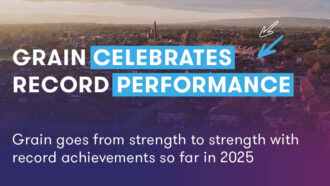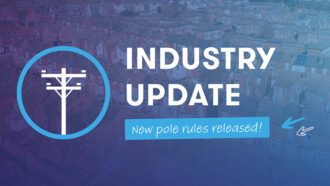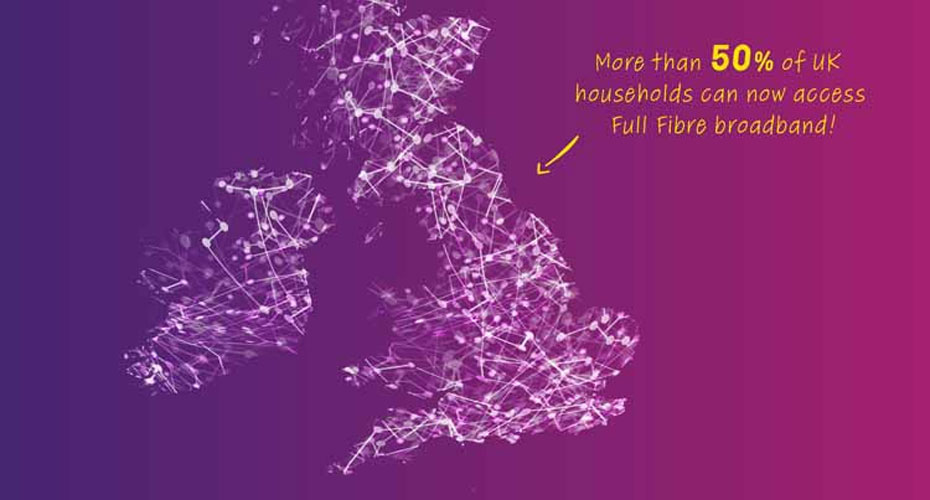More UK households get Full Fibre
Over 50% of UK households can now access Full Fibre broadband
8th September 2023
Full Fibre is taking over
Grain joins Ofcom in recognition of Full Fibre connectivity milestone success across the UK.
We are thrilled to see that nearly 15.4 million UK homes (52%) can now benefit from Full Fibre broadband and enjoy much faster speeds and greater reliability, with a Fibre to the Premises (FTTP) connection. These figures come as great news to residents and businesses that have been stuck using legacy networks, such as Fibre to the Cabinet (FTTC) or copper. Ofcom’s findings give a clear picture of availability, growth, and coverage across the country.
The public have seen a sharp increase in the Full Fibre network availability in their local areas. This noticeable rise has been driven by broadband providers focusing efforts in towns and cities UK-wide, with more network development and planning required for the final push towards a gigabit-capable Britain.
Here at Grain, we believe Full Fibre broadband is no longer a luxury but a necessity for the public, due to modern age technology and the digitally connected lives we all live today. As a result, everyone should have access to fast, reliable, and affordable broadband.
Grain CFO Roland Barzegar responded to Ofcom’s announcement, by adding “We target communities where we see the greatest need for improved connectivity, whether that is delivering a Full Fibre connection to new build developments across the country, or bringing fibre to homes that still suffer from slow copper connectivity”.
What’s the difference between the traditional network and Full Fibre broadband?
It’s important to learn the difference between true Full Fibre and the other services out there, so you can make the best decision for your broadband needs, and your budgets!
Exchange-only-line or EOL
This is a copper system that transmits data through electrical signals, resulting in slower speeds and higher lag. These are often older lines that were installed before fibre-optic technology became widespread.
Fibre to the cabinet (FTTC)
This is a partially fibre network, which uses fibre-optic between the local exchange and the street cabinet, then traditional copper for the last-mile connection – drastically slowing your speeds.
To attract customers, some providers use misleading terms like ‘fibre-optic broadband’ when only providing this partial fibre. Steer clear of fake fibre – find out more about the difference, here.
Full Fibre, or Fibre to the Premises (FTTP)
Fibre optic uses strands of optically pure glass to transmit data as pulses of light. These pulses travel at the speed of light, providing incredible speeds and bandwidth potential – literally lightning fast!
Grain Full Fibre broadband
Our broadband network is designed with the future in mind. Not only do we offer Fibre-to-the-Premises, but our Point-to-Point (PTP) architecture means each-and-every home or business gets their own dedicated fibre-optic cable – straight into the router!
While some providers offer something called Passive Optical Network (PON), which splits a single fibre between multiple properties, our approach guarantees a superior broadband experience for each connected customer.
Sounds expensive right?
Wrong! Full Fibre doesn’t need to mean expensive. There’s an old myth still lingering that because it’s a new network with super-fast speeds and perks, it comes with a hefty price tag.
For us, as we build our own independent network, we have full control over our own prices. This means we’re able to provide next-generation broadband, at inclusive prices – meaning all households across the UK can afford to take advantage and have the same opportunities!
Read more about Ofcom’s update on the Full Fibre takeover, here.
Check your postcode on our website to see if your home can benefit from the latest Full Fibre broadband technology.
Share this article
Related Articles

Industry News | Apr 14, 2025
Grain celebrates records in financial and customer performance

Industry News | Apr 12, 2025
The Best Broadband for Streaming: Upcoming Must-Watch Releases

Industry News | Mar 28, 2025

